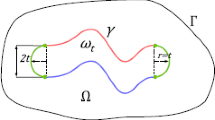We consider the equilibrium problem for plates with cracks located along rigid inclusions and analyze the dependence of the solution and the derivative of the energy functional on variations of the inclusion size. We establish the solvability of the optimal control problem, where the quality functional is given by the derivative of the energy functional, whereas the control parameter correspond to the inclusion size. A similar analysis is performed for the equilibrium problems for inhomogeneous plates with rigid delaminated inclusions.
Similar content being viewed by others
References
A. M. Khludnev and V. A. Kovtunenko, Analysis of Cracks in Solids,WIT-Press, Southampton etc. (2000).
B. L. Pelekh, Theory of Shells with Finite Shear Modulus [in Russian], Naukova Dumka, Kiev (1973).
N. P. Lazarev, “The equilibrium problem for a Timoshenko-type plate containing a crack on the boundary of a rigid inclusion,” J. Sib. Federal Univ., Math. Phys. [in Russian] 6, No. 1, 53–62 (2013).
N. P. Lazarev, “Fictitious domain method in the equilibrium problem for a Timoshenko type plate contacting with a rigid obstacle,” J. Math. Sci., New York 203, No. 4, 527–539 (2014).
N. P. Lazarev, “The equilibrium problem for a Timoshenko plate containing a crack along a thin rigid inclusion” [in Russian], Vestn. Udmurt. Univ., Mat. Mekh. Komp’yut. Nauki 2014, No. 1, 32–45 (2014).
N. P. Lazarev, ”Differentiation of the energy functional in the equilibrium problem for a Timoshenko plate containing a crack,” J. Appl. Mech. Tech. Phys. 53, No. 2, 299–307 (2012).
N. P. Lazarev, “Shape sensitivity analysis of the energy integrals for the Timoshenko-type plate containing a crack on the boundary of a rigid inclusion,” Z. Angew. Math. Phys. 66, No. 4, 2025–2040 (2015).
E. M. Rudoy, “Shape derivative of the energy functional in a problem for a thin rigid inclusion in an elastic body,” Z. Angew. Math. Phys. 66, No. 4, 1923–1937 (2015).
A. M. Khludnev, Elasticity Problems in Nonsmooth Domains [in Russian], Fizmatlit, Moscow (2010).
V. A. Kovtunenko, “Primal-dual methods of shape sensitivity analysis for curvilinear cracks with nonpenetration,” IMA J. Appl. Math. 71, No. 5, 635–657 (2006).
M. Hinterm¨uller and V. A. Kovtunenko, “From shape variation to topology changes in constrained minimization: A velocity method based concept,” Optim. Methods Softw. 26, No. 4–5, 513–532 (2011).
E. M. Rudoy, “Differentiation of energy functionals in the problem of a curvilinear crack in a plate with a possible contact of the crack faces,” J. Appl. Mech. Tech. Phys. 49, No. 5, 832–845 (2008).
G. Lazzaroni and R. Toader, “Energy release rate and stress intensity factor in antiplane elasticity,” J. Math. Pures Appl. 95, No. 6, 565–584 (2011).
V. Z. Parton and E. M. Morozov, Mechanics of Elastic-Plastic Fracture, Hemisphere Publishing Corp., Washington, DC (1989).
G. P. Cherepanov, Mechanics of Brittle Fracture, McGraw-Hill, New York etc. (1979).
C. Baiocchi and A. Capello, Variational and Quasivariational Inequalities: Application to Free Boundary Problems, John Wiley & Sons, New York (1984).
V. G. Maz’ya, Sobolev Spaces, Springer, Berlin (1985).
Author information
Authors and Affiliations
Corresponding author
Additional information
Translated from Sibirskii Zhurnal Chistoi i Prikladnoi Matematiki 16, No. 1, 2016, pp. 90-105.
Rights and permissions
About this article
Cite this article
Lazarev, N.P. Optimal Control of the Rigid Inclusion Size in the Problem of Equilibrium of Inhomogeneous Timoshenko Type Plates Containing Cracks. J Math Sci 228, 409–420 (2018). https://doi.org/10.1007/s10958-017-3631-x
Received:
Published:
Issue Date:
DOI: https://doi.org/10.1007/s10958-017-3631-x



